Feature: No Sleep Till Denver
Originally posted on July 12, 2016 at 15:20 pm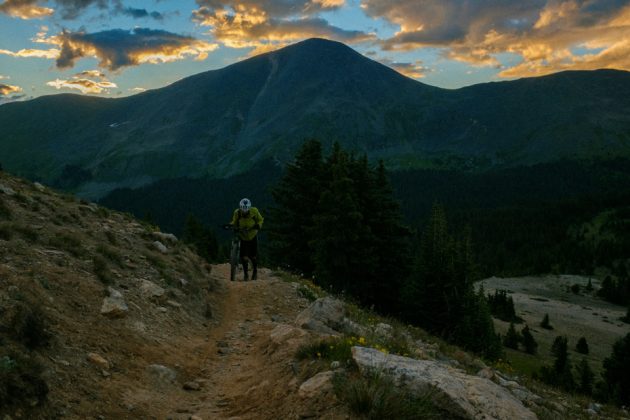
Words and photos: Montana Miller
Originally published in Issue #191
My back just went numb, right between the shoulder blades. Which actually feels a lot better than the shooting pain I had a few minutes ago. I hike slowly next to my bike; hopefully I can make the top of this pass before sunset. I’m 16 hours into the first day and I’m still hours from the first resupply in Silverton, Colorado, at an elevation of more than 9,000 feet. This is way harder than I thought it’d be.
This is the Colorado Trail Race, a 540-mile competition from Durango to Denver. It’s entirely self-supported, with no entry fee, no registration and no pre-planned resupplies allowed unless you mail them to a post office along the way. The rules also forbid calling ahead to make hotel reservations (most competitors camp along the course anyway). It’s not broken into stages—it is an individual time trial—so riders who go the fastest will be riders who sleep the least.
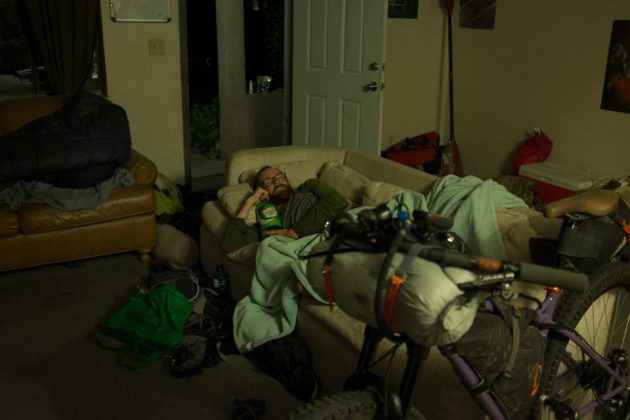
It’s a few minutes before the 4 a.m. start. Nervous. Seventy riders with crossed arms, some hopping up and down in rain jackets to stay warm. Headlight beams flashing, shoes clicking into pedals, derailleurs snapping through gears. The pack moves up the empty pavement, away from town.
Onto singletrack, a few guys get excited and we start to move fast. Jesse Jakomait, who’s one of the guys who could win this year, sprints away. His light gets smaller and smaller as he winds up the steep switchbacks. I wonder if he’ll be able to hold that pace. Dust swirling in front of my headlight makes it hard to breathe.
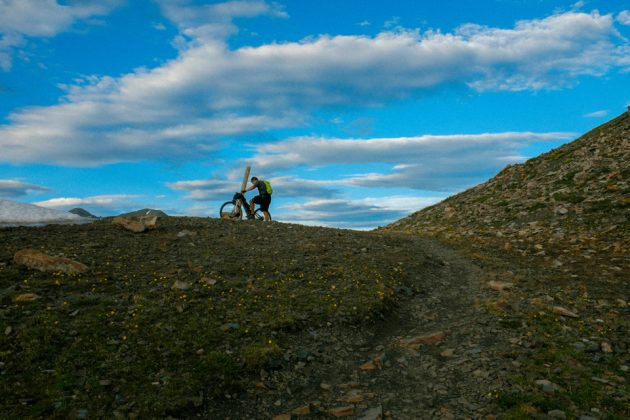
A few hours later, in weak morning light, we are close to the top of Kenosha Pass in cold rain. I stop in a scree field to put my rain jacket on. “I hoped we wouldn’t get the weather so soon,” says a rider close to me. “Mountains do what they want,” is my reply.
It takes all morning to make it to the top of the first climb, 6,500 feet above Durango on Indian Trail Ridge. I can’t stop yawning; I would kill for a cup of coffee. I get on my bike and try to ride the rocky, knife-edge trail. A fat marmot stares at me, matted fur, yellow teeth curled over his lip, barely stepping off the trail as I dizzily ride past, making it perfectly clear who owns that spot.
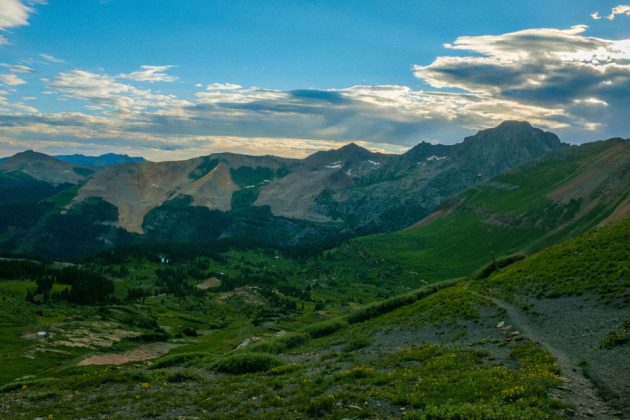
Gray clouds swirl around the mountains. I lean back until my butt is on top of my seat bag, pull the brakes, inch around a tight switchback with a long drop off the outside. Letting off the brakes, the bike picks up speed and drops fast to the bottom of the saddle. Blackhawk Pass, Molas Pass, Bolam Pass. Walk up, boil hydraulic fluid on the way down. The trail hits every little rise, every high point, never dropping below 11,000 feet. Late in the day, I finally make the top of another pass.
It feels like there’s no way I’ll be able to make it to Denver—16 hours of hard riding and I’ve covered only 75 miles. I’ve finished hundred-milers in half that time. I’ll quit in Silverton tomorrow. It’s too much.
I throw my sleeping bag on the ground at the bottom of a pass, and I’m asleep as soon as my face hits the pine duff. I started dreaming about this race seven years ago, a high school kid on a laptop under a steel bunk bed in gray, rusty Greensburg, Pennsylvania. Ethan Passant and Jefe Branham were breaking new ground, covering huge miles without sleep. I was skidding a dozen-year-old Gary Fisher around on some slag heaps. I’d never seen a real mountain, other than the ones that glowed through that little computer screen.
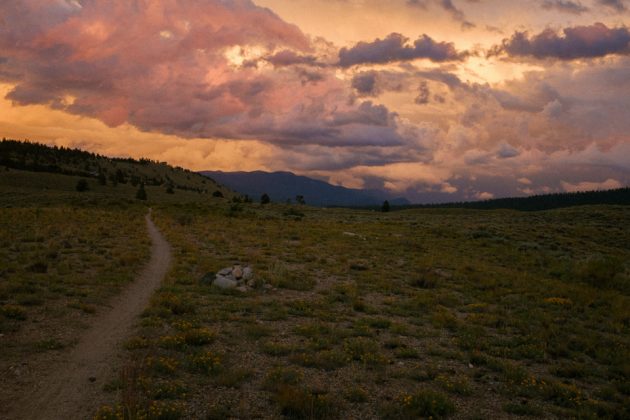
Up before sunrise, headed for Silverton. The sun throws weak pink light on the reddish brown and gray mountains. There’s some good singletrack descending, and I can hear the highway. Pavement to the gas station, a few miles to relax. The sausage sandwich is hot, and that’s all the good I can say about it. Cold, canned espresso, because drinking watery gas-station coffee would be like trying to start a fire with olive oil. Stretch my back. Everything hurts. And only 475 miles to go.
The morning sun creeps over the tall walls of the box canyon. But, man, I’ve wanted to see this trail for so long. I could try another day, see if it gets better. Back in the gas station to resupply: three pepperoni Hot Pockets, two bags of peanuts and a couple cheese Danishes. I don’t think Salida’s much more than a day and a half away.
On the bike and out of Silverton, past the last coffee shop. For a really long time. I swing around and grab one more coffee. A couple hours later I’m grinding to the top of Stony Pass. A rider sits in the scree at the start of the singletrack; Colorado’s finest natural painkiller and antidepressant burns between his fingertips. I sit down next to him to rest. “Any idea how this next section is?” I ask. “Hard. You know how it is, man,” he says, and exhales a swirl of white smoke. “Just keep going until it stops.”

He’s not a liar. I push my bike up to the top of a peak at almost 13,000 feet. Wind screams over the mountain fast enough to make me stumble sideways. Scrubby grass and tiny flowers ripple and wave, green, yellow and pink. The trail rolls for miles, then out of sight over the next peak. Crossing the San Juans. Next time I make it to a place where there’s enough oxygen for my brain to work, I’ll think this was incredible.
I clip in to drop down, picking up speed fast. I see a few tiny dots way up the next mountain. Hike faster. Bikes come into focus. An hour later I’m just a switchback below them. When I walk past, none of us can spare enough breath to say much, even though we’re barely moving. The riders slowly fade back to tiny dots.

Hours later, I make the high point of the route at 13,300 feet. I lean my bike against the sign and sit. Man, there’s a lot more of this to go, but maybe I’ll actually be able to make it. Just keep going until it stops. I crunch on a mouthful of peanuts. Another sunset, and I struggle to the summit of a mountain that slopes so gently that it hardly deserves the title. But I still can’t ride it. The meadow is so rocky and the trail so faint that I have to just stomp along next to my bike, make beelines between wooden trail markers. Moving 3 miles an hour, making hundreds of miles seems hopeless.
Dark morning on the third day. I covered most of a long road detour last night, slept next to the road until I heard tires crunch past. I’m stopped next to an irrigation ditch to filter water; I wiggle my frozen fingers to try to get some feeling back. My water purification chemicals turn bright yellow in the mixing cup; the sun slides above the ridge.

Trapped in an endless rock garden. Head down, walking up the steep trail. I thought for sure I could make it through this 20-mile segment in a few hours, but it’s already been four. Sargents Mesa. No views or summits—just trees, rocks and fall-line climbs. Close to the top of the mesa, an old guy on a moto buzzes up the trail. Cuts the engine.
“Nice bicycle you got there,” he says, smiling a little. “I know I shouldn’t be up here on my motorcycle, but no chance I could make it any other way with my back being the way it is.”
“Hey, doesn’t bother me, man.”
“You know where Sargents Mesa starts? I’m looking for the Vietnam memorial up there.”
“I think this is the top of the mesa. Couldn’t say where the memorial is, though.”
“Thanks. I’ll just keep looking.”
He cranks the motor over. I get back on and start to pedal away, a little embarrassed at how down I was a few minutes ago. You’re not doing anything actually hard out here, not compared to what that guy probably did when he was your age. It’s just a hard bike ride, and nobody’s shooting. Suck it up and enjoy the scenery.

My back tire hisses, starts to squirm. Fudge. I put on the brakes and drift to the side of the trail. Sidewall cut. Dig through my frame bag to find my repair stuff. I’ll try a tire plug. Maybe it’ll save my tubeless. Another rider hikes up the trail toward me. We’re out of the trees in the afternoon sun, and he looks as burnt as my mom’s cooking. “How goes it? You racing?” I ask, crouched over my tire.
“Yeah. Left Denver on Saturday. Is there any water up there?” he rasps.
“I don’t remember anything until the other side of Windy Peak, and that’s pretty far. Some dirty puddles on the trail up there—I’d go for those if you’re close to out.”
“Oh. Damn, I should have filled up on Marshall Pass. I already lost a day in Buena Vista with heat exhaustion. Will the dirt in the water make me sick?”
I look up at him. Seems weird to be trying this trail without knowing how to filter water. “I don’t know, man; maybe try a sock to filter some of the dirt out.”
“Oh, that’s a good idea. Thanks. You have everything you need?” he says.
“Have any iced coffee?”
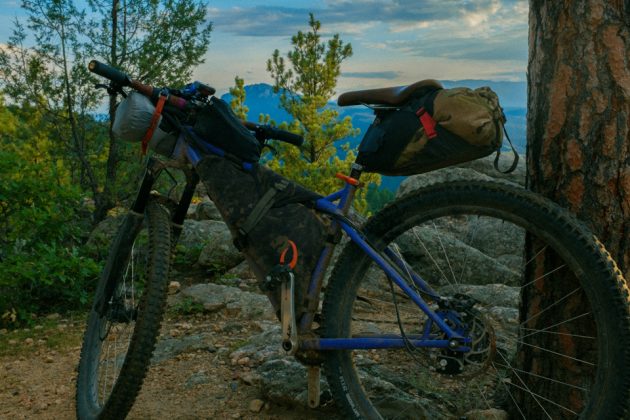
I shove the plug into my sidewall and start pumping. Over Marshall Pass, on the Monarch Crest. The sun drops, deep raspberry red. I stop in an avalanche path, wide open between the trees. Mountains stretch out for hundreds of miles. I just rode (or mostly walked) over those things. It seems impossible. And felt like it. Halfway there, halfway to go. I climb a little longer, then flop down on top of some pinecones.
Descending Fooses Creek Trail in the morning dew. Big root drops, steep, wet. First my left hand—no tapping the front brake here. I really hope I can make Buena Vista before this afternoon; it’s already been two days since I resupplied in Silverton, and I’m down to a few handfuls of peanuts. After this descent, there aren’t any huge climbs, so hopefully it’ll go fast.
It doesn’t go fast. By the time I cover the 40 miles of relentlessly up-and-down trail around the base of Mount Princeton, it’s late afternoon and I’ve been out of food for a few hours. When I heard people say it was 200 miles without resupply from Silverton to Buena Vista, for some reason I assumed they were rounding up.
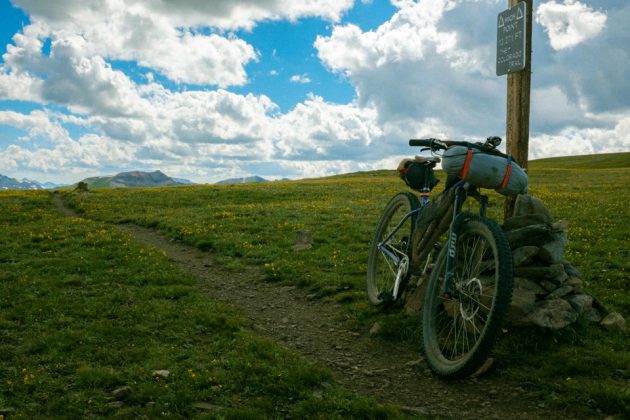
I roll into town running on that handful of nuts from six hours ago, grab a burger and fill my top-tube bag with french fries. Maybe I’ll be able to get to Leadville before sunset.
I can’t. It’s midnight by the time I roll into the old mining town. A Nas track thumps from the kitchen of a closing restaurant next to the 24- hour gas station. I buy a few sacks of peanuts and call my wife from a pay phone. Leave a message after the beep. “Hey, sorry I haven’t been in touch. Phone died a couple days ago and I still haven’t found batteries for my tracker. This is real tough. I’m gonna go as far as I can tonight, though.” I hang up the receiver and pedal the dark highway out of town.
Over Tennessee Pass, there’s a puffy lump asleep next to a bike, then another. After seeing only tire tracks for three days, it feels like I’m in a race again.
Descend for an hour to the overgrown concrete slabs of Camp Hale, where the 10th Mountain Division trained to fight in the Alps during the Second World War. It’s almost three in the morning. I’ve gotta sleep for a minute.
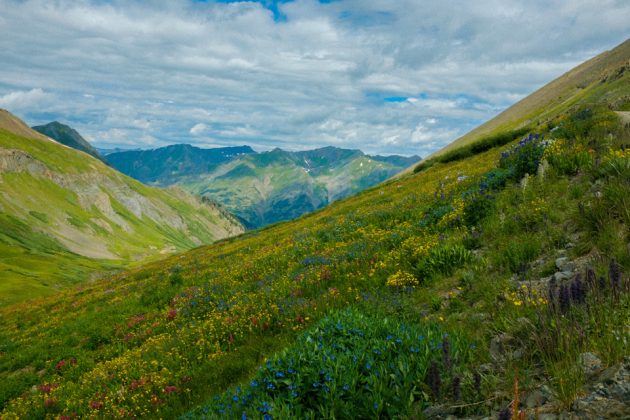
The next morning, I’m in a field of wildflowers, almost on top of the pass before the sun comes up. There’s a wooden sign at the top. Oh, boy—just a descent now. I’m gonna make it to Copper at a reasonable hour for coffee. I look at the sign for mileage to town: “Searle Pass 2 mi.” Turds. This high up, it’ll take almost an hour to hit the top of that next pass.
By the time I finish the long, pedal-y descent to town, it’s past lunchtime. No morning coffee. Everything takes longer than I think it should out here. I ride the highway down to a gas station next to I-70 and the place is jammed. Fleshy tourists jiggle to the bathrooms, a long line of people buy candy bars and coffee lighter than iced tea as an endless stream of cars whooshes by on the interstate. When I finally get to the front of the line to pay for my soggy ham sandwich, I can’t wait to get out of there and start pushing my bike up another pass.
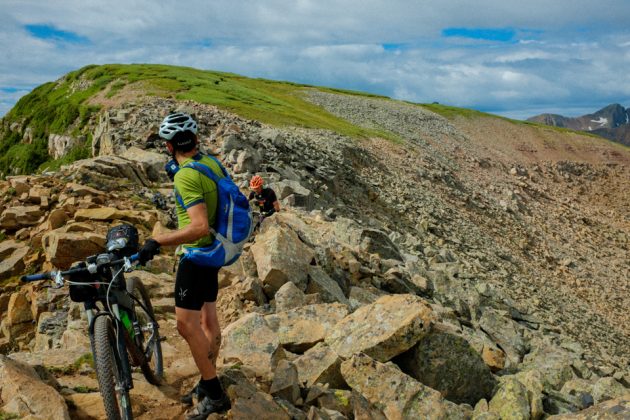
I don’t have to wait long. A few thousand shuffling steps and three hours later, I climb up to some pointless nub, which is inaccurately named Ten Mile Pass. (A pass should be in a saddle, on the low point of a ridge—something that must not have been explained to whoever routed this trail).
I push my bike over and start the rough, hand-numbing descent down the other side toward Breckenridge. After the downhill, the rest of the afternoon is beautiful, effortless, flowing dirt. With heavy legs, a pinched feeling at the top of my spine and tingly hands, it feels real good to just cruise.
Georgia Pass in the moonlight. Wind blows softly through the tundra. I get off my bike and put my forehead in the dirt. This trail is wrecking me. Completely. But I’m going to ride to the end of it. Deep breath and back on the bike. The white light from my Dynamo glows brighter as I roll faster down the mountain. Things reach out to grab at me. My eyes shut. Wake up in the middle of a corner, going 20 miles an hour. Pop a caffeine pill. Keep it together a little longer. It’s two in the morning. I’ll just sleep an hour. Six in the morning, the sun is coming up over the Front Range. The end of the mountains. Goddamn, I’ve almost made it.

Seventy miles on a road detour through a burned forest starting to grow back. Little green shoots around the base of wood skeletons. The sun is searing, then it rains. Flowing singletrack in Buffalo Creek. Only 35 miles to go now.
Mud. Slow, sticky, sucking mud. I’m so close to the finish in Waterton Canyon. I grind along at a couple miles an hour. Check the GPS. Only 20 miles to go. That’ s 10 hours at this rate. I’m not riding through another night.
I snap, scream at the mountains, suggest that they enjoy eating Popsicles made out of feces. The mountains just stand there, unoffended. Real mad, I ride faster. Down to the river, up the last big climb, almost going cross-country race pace now, I crash on a dusty switchback. Pick myself up, spin the bars around. OK, relax, man. It’s really almost over now. Finally off the singletrack, onto the road through the canyon. I put it in a big gear and crank. The sun sets, I roll into the parking lot. My wife walks over to meet me.
“Nice work, five and a half days!” says somebody standing next to a van.
“Five? I thought it was six,” I say.
“Nope.”
Apparently I lost a day out there. “Oh, well that’s great.”
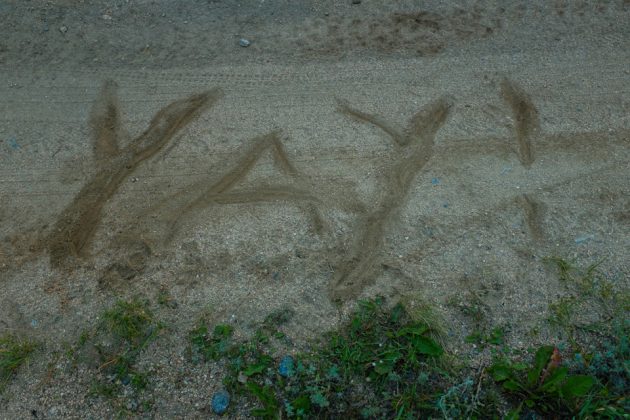
Colorado Trail Race Facts
- 540 miles
- 74,000 feet of climbing
- Race start time: 4:02 a.m.
- My 11th place finishing time: 5 days, 16 hours, 28 minutes
- Winning time and new course record set by Jesse Jakomait: 3 days, 20 hours, 44 minutes
- Final finishers time: 12 days, 12 hours, 19 minutes
- Trail Magic: Unexpected and unplanned support from a random person giving you a coke or snack or finding a box of girl scout cookies on the side of the road
- 2016’s event on July 24 will run reverse: Denver to Durango